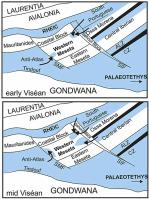当前位置:
X-MOL 学术
›
J. Afr. Earth Sci.
›
论文详情
Our official English website, www.x-mol.net, welcomes your
feedback! (Note: you will need to create a separate account there.)
Lower-middle Viséan transgressive carbonates in Morocco: Palaeobiogeographic insights
Journal of African Earth Sciences ( IF 2.2 ) Pub Date : 2020-08-01 , DOI: 10.1016/j.jafrearsci.2020.103850 Pedro Cózar , Daniel Vachard , Alain Izart , Ismael Said , Ian Somerville , Sergio Rodríguez , Ismael Coronado , Mohamed El Houicha , Driss Ouarhache
Journal of African Earth Sciences ( IF 2.2 ) Pub Date : 2020-08-01 , DOI: 10.1016/j.jafrearsci.2020.103850 Pedro Cózar , Daniel Vachard , Alain Izart , Ismael Said , Ian Somerville , Sergio Rodríguez , Ismael Coronado , Mohamed El Houicha , Driss Ouarhache

|
Abstract Foraminifera have been used to revise the biostratigraphy of all known Mississippian outcrops in Morocco cited either as early Visean (or its equivalent V2a or V2a/b chronozones or the regional Cfm1 biozones), or mid Visean (or the foraminiferal zones V2b-V3a or Cfm 2-Cfm 3 biozones). This group of microfossils occur in shallow-water limestones within siliciclastic-dominant successions. Most of the previously determined lower Visean ages for the outcrops are now interpreted either as middle or even late Visean. Similarly, some outcrops originally assigned to the mid Visean are now considered as late Visean. Only two successions can be confirmed as belonging to the early Visean in the Western Meseta. The first succession, of uppermost lower Visean age (Cf4γ-δ subzones or MFZ11 zone), occurs in the lower part of the Sidi Sebaa Formation in the Mdakra Massif (south of the Sidi Bettache Basin). The second succession occurs in a small area in the lower part of the Khenifra Nappe (in the so-called Hvs1’ Formation), which is assigned to the base of the Visean (Cf4α2 subzone or MFZ9 zone). Middle Visean outcrops are more common, occurring in the western part of the Western Meseta (Mdakra and Khatouat massifs), north-central Western Meseta (Tilouine, Bouqachmir, El Goulib, Jbel Bouechchot), as well as in the South Western Meseta (Haouz-High Atlas of Marrakech) and the central High Atlas (Skoura). In contrast, the Visean succession in the Anti-Atlas domain is more continuous, from early to mid Visean. This scarcity of lower Visean outcrops suggests that the Moroccan Meseta was mostly an uplifted region at that time. The recognition of the early Visean in the Mdakra Massif suggests a marine connection from the west or northwest, linked with the Rheic Ocean, with an opposite orientation (from the southeast) for the main transgressions in the Meseta in the late Visean. Taking into consideration previous tectonic reconstructions of Morocco, the presence of early Visean marine rocks in the Khenifra region can only be explained by a southward connection with the Sahara across the Tinerhir and Tafilalt regions linking with the Palaeotethys Ocean, which later covered areas within the High Atlas during the mid Visean. This connection during the early Visean, suggests a relatively close position between the Moroccan Meseta and Gondwana, in spite of the disparity in the lithological successions; this is also recognized in the mid Visean. Thus, it appears that the Moroccan Meseta had not yet achieved its final emplacement completely juxtaposed to Gondwana.
中文翻译:

摩洛哥中下维塞恩海侵碳酸盐岩:古生物地理见解
摘要 有孔虫已被用于修改摩洛哥所有已知的密西西比露头的生物地层学,这些地层被引用为早期 Visean(或其等效的 V2a 或 V2a/b 年代带或区域 Cfm1 生物区),或中期 Visean(或有孔虫区 V2b-V3a 或Cfm 2-Cfm 3 生物区)。这组微化石出现在以硅质碎屑岩为主的系列中的浅水石灰岩中。大多数先前确定的露头的较低维森时代现在被解释为中维森时代甚至晚维森时代。类似地,一些最初分配给中维赛安的露头现在被认为是晚维赛安。只有两个继承可以被确认属于西梅塞塔早期的维仙人。第一个序列,最上层的下维氏时代(Cf4γ-δ 亚带或 MFZ11 带),产于 Mdakra 地块的 Sidi Sebaa 组下部(Sidi Bettache 盆地以南)。第二个系列发生在 Khenifra Nappe 下部的一个小区域(在所谓的 Hvs1' 组中),该区域被分配到 Visean 的底部(Cf4α2 子带或 MFZ9 带)。Middle Visean 露头更常见,发生在西 Meseta 的西部(Mdakra 和 Khatouat 地块)、西 Meseta 中北部(Tilouine、Bouqachmir、El Goulib、Jbel Bouechchot),以及 Meseta 西南部(Haouz -马拉喀什高地图集)和中央高地图集(斯库拉)。相比之下,Anti-Atlas 域中的 Visean 序列更连续,从早期到中期的 Visean。这种低维赛恩露头的稀缺表明摩洛哥梅塞塔当时主要是一个隆起的地区。对 Mdakra 地块中早期 Visean 的识别表明,从西部或西北部与 Rheic 洋相连,与晚期 Visean 的 Meseta 的主要海侵方向相反(从东南方向)。考虑到摩洛哥先前的构造重建,Khenifra 地区早期维赛安海相岩石的存在只能通过向南与跨越 Tinerhir 和 Tafilalt 地区的撒哈拉联系来解释,该地区与古特提斯洋相连,后者后来覆盖了高地内的区域。维西安中期的阿特拉斯。尽管在岩性序列上存在差异,但早期维赛期的这种联系表明摩洛哥梅塞塔和冈瓦纳之间的位置相对较近;这一点在维赛安中期也得到了认可。因此,
更新日期:2020-08-01
中文翻译:

摩洛哥中下维塞恩海侵碳酸盐岩:古生物地理见解
摘要 有孔虫已被用于修改摩洛哥所有已知的密西西比露头的生物地层学,这些地层被引用为早期 Visean(或其等效的 V2a 或 V2a/b 年代带或区域 Cfm1 生物区),或中期 Visean(或有孔虫区 V2b-V3a 或Cfm 2-Cfm 3 生物区)。这组微化石出现在以硅质碎屑岩为主的系列中的浅水石灰岩中。大多数先前确定的露头的较低维森时代现在被解释为中维森时代甚至晚维森时代。类似地,一些最初分配给中维赛安的露头现在被认为是晚维赛安。只有两个继承可以被确认属于西梅塞塔早期的维仙人。第一个序列,最上层的下维氏时代(Cf4γ-δ 亚带或 MFZ11 带),产于 Mdakra 地块的 Sidi Sebaa 组下部(Sidi Bettache 盆地以南)。第二个系列发生在 Khenifra Nappe 下部的一个小区域(在所谓的 Hvs1' 组中),该区域被分配到 Visean 的底部(Cf4α2 子带或 MFZ9 带)。Middle Visean 露头更常见,发生在西 Meseta 的西部(Mdakra 和 Khatouat 地块)、西 Meseta 中北部(Tilouine、Bouqachmir、El Goulib、Jbel Bouechchot),以及 Meseta 西南部(Haouz -马拉喀什高地图集)和中央高地图集(斯库拉)。相比之下,Anti-Atlas 域中的 Visean 序列更连续,从早期到中期的 Visean。这种低维赛恩露头的稀缺表明摩洛哥梅塞塔当时主要是一个隆起的地区。对 Mdakra 地块中早期 Visean 的识别表明,从西部或西北部与 Rheic 洋相连,与晚期 Visean 的 Meseta 的主要海侵方向相反(从东南方向)。考虑到摩洛哥先前的构造重建,Khenifra 地区早期维赛安海相岩石的存在只能通过向南与跨越 Tinerhir 和 Tafilalt 地区的撒哈拉联系来解释,该地区与古特提斯洋相连,后者后来覆盖了高地内的区域。维西安中期的阿特拉斯。尽管在岩性序列上存在差异,但早期维赛期的这种联系表明摩洛哥梅塞塔和冈瓦纳之间的位置相对较近;这一点在维赛安中期也得到了认可。因此,











































 京公网安备 11010802027423号
京公网安备 11010802027423号